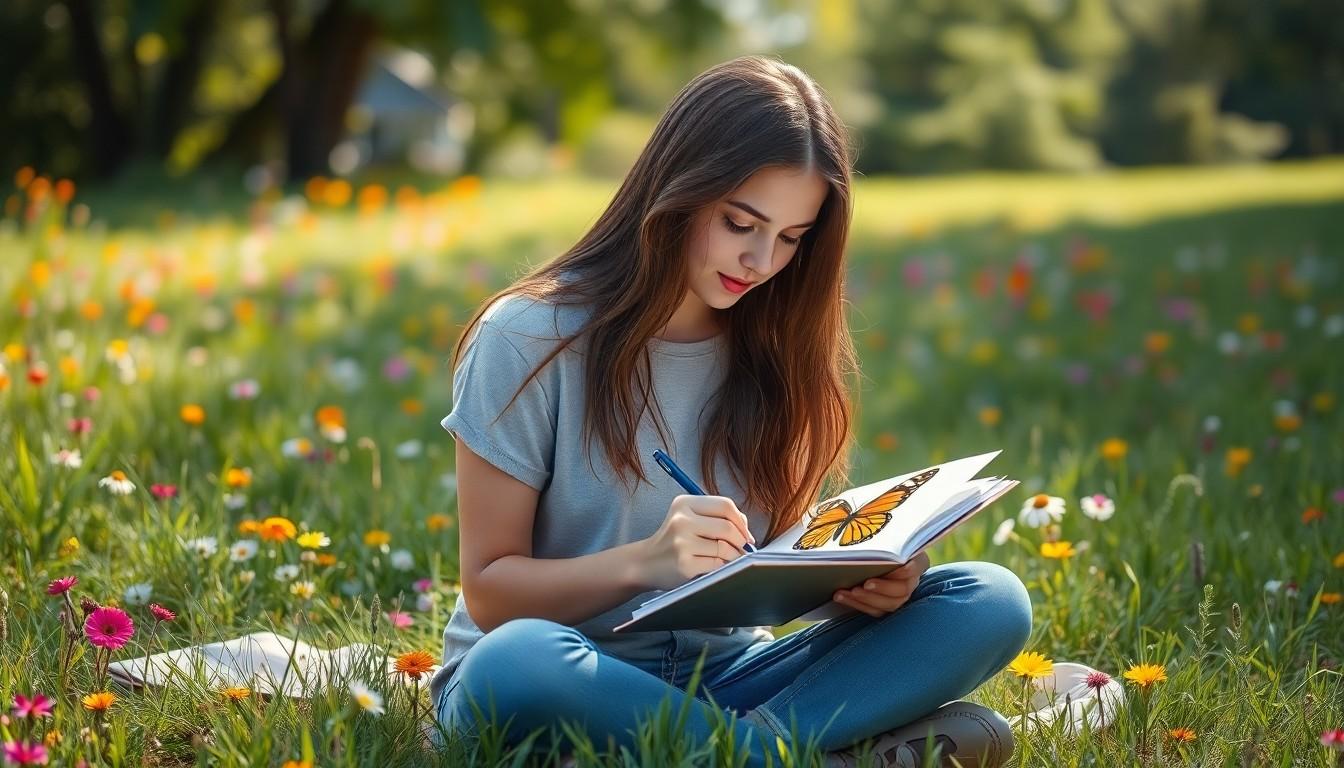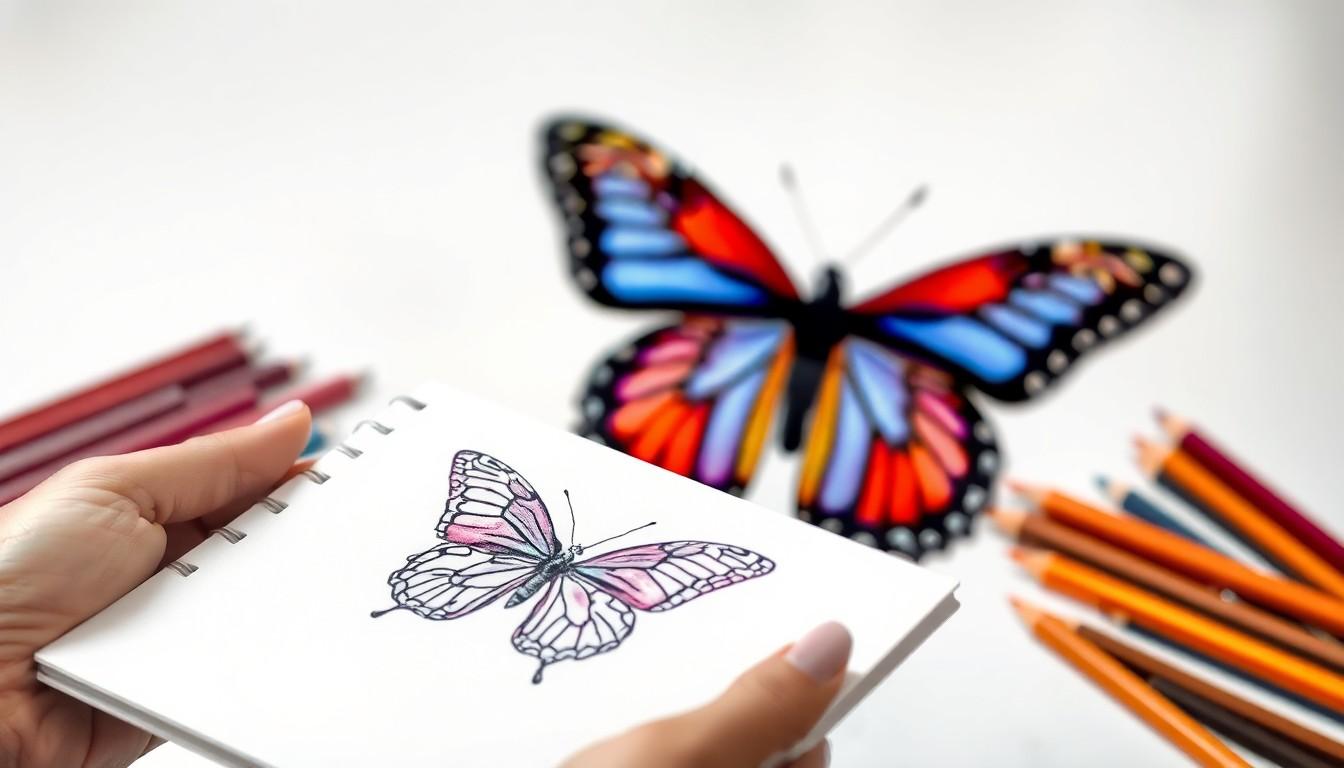
Butterfly Drawing: Unleash Your Creativity and Discover Joy in Every Stroke
Butterflies are nature’s little masterpieces, and what better way to celebrate their beauty than by putting pencil to paper? Drawing butterflies isn’t just for art class; it’s a delightful escape into a world of color and creativity. Whether you’re a seasoned artist or someone who thinks a stick figure is a big achievement, butterfly drawing can transform your doodles into a fluttering spectacle.
Butterfly Drawing
Butterfly drawing captivates many due to its vibrant colors and intricate designs. Engaging in this art form promotes creativity and personal expression.
Importance of Butterfly Drawing
Butterfly drawing offers numerous benefits beyond artistic skill. It acts as a therapeutic activity, reducing stress and enhancing focus. Creating butterfly illustrations fosters an appreciation for nature, enriching one’s understanding of biodiversity. Schools often incorporate butterfly drawing in art curricula, promoting cultural knowledge and creativity among students. Developing this skill allows individuals to explore various techniques and styles, encouraging ongoing artistic growth.
Historical Significance
The historical significance of butterfly drawing spans cultures and eras. Ancient civilizations viewed butterflies as symbols of transformation and renewal. In Japan, butterfly images often represent joy and new beginnings, appearing in traditional art forms. The Renaissance period saw artists incorporate butterfly motifs into their work, showcasing the beauty of nature. Over time, butterfly illustrations evolved, influencing contemporary art while maintaining their symbolic meanings. Recognizing this significance enhances appreciation for the intricate art of butterfly drawing.
Techniques for Butterfly Drawing
Exploring various techniques enhances the butterfly drawing experience. By combining different methods, artists can capture the unique beauty of these insects.
Traditional Methods
Pencil sketching offers a fundamental approach to butterfly drawing. It allows for precise outlines and the freedom to erase mistakes. Watercolor painting brings vibrancy to butterflies with its ability to blend colors seamlessly. Using oil pastels creates rich textures and depth, emphasizing patterns on wings. For enthusiasts, colored pencils provide detailed control over shading and blending. Each method contributes to a distinctive style, enriching the overall representation of butterflies.
Digital Techniques
Digital drawing opens a new realm for butterfly artists. Software like Adobe Illustrator allows for vector illustrations, ensuring scalability without loss of quality. Using drawing tablets combines traditional sketching techniques with modern tools, making it possible to experiment easily. Layering techniques enable artists to adjust colors and forms without damaging original work. Additionally, graphic design apps offer filters and effects that can enhance the final presentation. These digital methods enable creativity while simplifying the artistic process.
Tools and Materials for Butterfly Drawing
Selecting the right tools and materials enhances the butterfly drawing experience. Various options exist that cater to different styles and preferences.
Recommended Pencils and Brushes
Graphite pencils offer versatility, making them ideal for sketching initial outlines. Colored pencils provide vibrant hues that replicate natural butterfly colors effectively. For blending, he, she, or they can use blending tools or tortillons. Brushes, particularly fine-tipped watercolor brushes, allow for delicate washes, creating soft gradients. Round brushes and flat brushes serve well for detailed work, enhancing texture and designs. Ensure to have a variety of sizes for different effects, which helps achieve the desired look.
Paper Types and Textures
Different paper types influence the final outcome of butterfly drawings. Smooth paper suits colored pencil and graphite techniques well, allowing for clean lines. Textured paper provides depth, ideal for watercolor and pastels, as it captures more detail. Watercolor paper withstands liquid mediums, ensuring colors remain vibrant without buckling. Using mixed media paper accommodates various techniques, providing flexibility for artistic exploration. Choosing the right texture contributes significantly to the overall visual appeal.
Inspiration for Butterfly Drawing
Finding inspiration for butterfly drawing often starts in nature. Observing butterflies in their habitats reveals a wealth of colors and patterns. Artists can take note of their delicate wings and unique shapes. Outdoor environments such as gardens or parks provide perfect opportunities for firsthand observation. Documenting these moments through sketches aids in capturing their essence.
Nature Observation
Nature observation plays a crucial role in enhancing butterfly drawings. Sketching butterflies while observing their movements fosters creativity. Artists can study the details present in their wings, such as veins and gradients. Capturing the way light interacts with their colors adds depth to illustrations. Observing different butterfly species encourages exploration of varying styles and techniques.
Online Resources and Communities
Online resources and communities offer a wealth of inspiration for butterfly drawing. Digital platforms enable access to tutorials, reference images, and step-by-step guides. Artists can engage with forums focused on butterfly art, sharing experiences and techniques. Social media networks allow for the discovery of other artists’ works, inspiring new ideas. Participation in online challenges can spark motivation and creativity, pushing artists to expand their skills.
Exploration and Joy
Butterfly drawing offers a unique blend of creativity and personal expression that resonates with artists of all skill levels. By embracing various techniques and materials, individuals can capture the intricate beauty of these creatures while enjoying the therapeutic benefits of art. Whether through traditional methods or digital platforms, the journey of creating butterfly illustrations fosters a deeper appreciation for nature and its vibrant colors. Engaging with communities and seeking inspiration from the natural world further enriches this artistic experience. Ultimately, butterfly drawing is not just an art form; it’s a celebration of transformation and renewal that invites endless exploration and joy.
